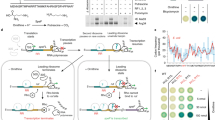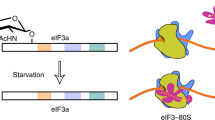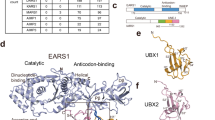Abstract
Polyamines are essential organic polycations with multiple cellular functions relevant for cell division, cancer and ageing1,2,3. Regulation of polyamine synthesis is mainly achieved by controlling the activity of ornithine decarboxylase (ODC) through an unusual mechanism involving ODC antizyme1,4, the binding of which disrupts homodimeric ODC and targets it for ubiquitin-independent degradation by the 26S proteasome5. Whereas mammals express several antizyme genes6, we have identified a single orthologue, termed OAZ1, in Saccharomyces cerevisiae7. Similar to its mammalian counterparts, OAZ1 synthesis is induced with rising intracellular polyamine concentrations, which also inhibit ubiquitin-dependent degradation of the OAZ1 protein7. Together, these mechanisms contribute to a homeostatic feedback regulation of polyamines1,7,8. Antizyme synthesis involves a conserved +1 ribosomal frameshifting (RFS) event at an internal STOP codon during decoding of its messenger RNA6,7,8,9,10. Here we used S. cerevisiae OAZ1 to dissect the enigmatic mechanism underlying polyamine regulation of RFS. In contrast with previous assumptions, we report here that the nascent antizyme polypeptide is the relevant polyamine sensor that operates in cis to negatively regulate upstream RFS on the polysomes, where its own mRNA is being translated. At low polyamine levels, the emerging antizyme polypeptide inhibits completion of its synthesis causing a ribosome pile-up on antizyme mRNA, whereas polyamine binding to nascent antizyme promotes completion of its synthesis. Thus, our study reveals a novel autoregulatory mechanism, in which binding of a small metabolite to a nascent sensor protein stimulates the latter’s synthesis co-translationally.
This is a preview of subscription content, access via your institution
Access options
Subscribe to this journal
Receive 51 print issues and online access
$199.00 per year
only $3.90 per issue
Buy this article
- Purchase on Springer Link
- Instant access to full article PDF
Prices may be subject to local taxes which are calculated during checkout




Similar content being viewed by others
References
Coffino, P. Regulation of cellular polyamines by antizyme. Nature Rev. Mol. Cell Biol. 2, 188–194 (2001)
Wallace, H. M., Fraser, A. V. & Hughes, A. A perspective of polyamine metabolism. Biochem. J. 376, 1–14 (2003)
Eisenberg, T. et al. Induction of autophagy by spermidine promotes longevity. Nature Cell Biol. 11, 1305–1314 (2009)
Hayashi, S., Murakami, Y. & Matsufuji, S. Ornithine decarboxylase antizyme: a novel type of regulatory protein. Trends Biochem. Sci. 21, 27–30 (1996)
Murakami, Y. et al. Ornithine decarboxylase is degraded by the 26S proteasome without ubiquitination. Nature 360, 597–599 (1992)
Ivanov, I. P. & Atkins, J. F. Ribosomal frameshifting in decoding antizyme mRNAs from yeast and protists to humans: close to 300 cases reveal remarkable diversity despite underlying conservation. Nucleic Acids Res. 35, 1842–1858 (2007)
Palanimurugan, R., Scheel, H., Hofmann, K. & Dohmen, R. J. Polyamines regulate their synthesis by inducing expression and blocking degradation of ODC antizyme. EMBO J. 23, 4857–4867 (2004)
Matsufuji, S. et al. Autoregulatory frameshifting in decoding mammalian ornithine decarboxylase antizyme. Cell 80, 51–60 (1995)
Rom, E. & Kahana, C. Polyamines regulate the expression of ornithine decarboxylase antizyme in vitro by inducing ribosomal frame-shifting. Proc. Natl Acad. Sci. USA 91, 3959–3963 (1994); erratum. 91, 9195 (1994)
Rato, C., Amirova, S. R., Bates, D. G., Stansfield, I. & Wallace, H. M. Translational recoding as a feedback controller: systems approaches reveal polyamine-specific effects on the antizyme ribosomal frameshift. Nucleic Acids Res. 39, 4587–4597 (2011)
Heinemeyer, W., Kleinschmidt, J. A., Saidowsky, J., Escher, C. & Wolf, D. H. Proteinase yscE, the yeast proteasome/multicatalytic-multifunctional proteinase: mutants unravel its function in stress induced proteolysis and uncover its necessity for cell survival. EMBO J. 10, 555–562 (1991)
Tenson, T. & Ehrenberg, M. Regulatory nascent peptides in the ribosomal tunnel. Cell 108, 591–594 (2002)
Inada, T. et al. One-step affinity purification of the yeast ribosome and its associated proteins and mRNAs. RNA 8, 948–958 (2002)
Arava, Y., Boas, F. E., Brown, P. O. & Herschlag, D. Dissecting eukaryotic translation and its control by ribosome density mapping. Nucleic Acids Res. 33, 2421–2432 (2005)
Baim, S. B. & Sherman, F. mRNA structures influencing translation in the yeast Saccharomyces cerevisiae. Mol. Cell. Biol. 8, 1591–1601 (1988)
Hoffman, D. W., Carroll, D., Martinez, N. & Hackert, M. L. Solution structure of a conserved domain of antizyme: a protein regulator of polyamines. Biochemistry 44, 11777–11785 (2005)
Nakatogawa, H. & Ito, K. The ribosomal exit tunnel functions as a discriminating gate. Cell 108, 629–636 (2002)
Woolhead, C. A., Johnson, A. E. & Bernstein, H. D. Translation arrest requires two-way communication between a nascent polypeptide and the ribosome. Mol. Cell 22, 587–598 (2006)
Butcher, N. J., Broadhurst, G. M. & Minchin, R. F. Polyamine-dependent regulation of spermidine-spermine N1-acetyltransferase mRNA translation. J. Biol. Chem. 282, 28530–28539 (2007)
Basuroy, U. K. & Gerner, E. W. Emerging concepts in targeting the polyamine metabolic pathway in epithelial cancer chemoprevention and chemotherapy. J. Biochem. 139, 27–33 (2006)
Lim, S. K. & Gopalan, G. Antizyme1 mediates AURKAIP1-dependent degradation of Aurora-A. Oncogene 26, 6593–6603 (2007)
Dulloo, I., Gopalan, G., Melino, G. & Sabapathy, K. The antiapoptotic DeltaNp73 is degraded in a c-Jun-dependent manner upon genotoxic stress through the antizyme-mediated pathway. Proc. Natl Acad. Sci. USA 107, 4902–4907 (2010)
Acknowledgements
We thank M. Hochstrasser for comments, D. Richardson for critical reading of the manuscript, and D. H. Wolf for the pre1-1 strain. L.K. and D.G. were supported by the NRW Graduate School in Genetics and Functional Genomics. This work was supported by a grant from the Deutsche Forschungsgemeinschaft (Do 649/4) to R.J.D.
Author information
Authors and Affiliations
Contributions
All authors contributed to the design of experiments. L.K. and R.P. generated constructs, performed RFS assays and analysed data. L.K. performed ribosome pull-down experiments. D.G. established expression and purification of 6His–OAZ1. R.P. established and performed polyamine binding assays (with help from D.G.), and performed all experiments in the revision process (Supplementary Figs. 3, 7, 8, 9 and 10). R.P. and R.J.D. wrote the manuscript with contributions from L.K. and D.G.
Corresponding author
Ethics declarations
Competing interests
The authors declare no competing financial interests.
Supplementary information
Supplementary Information
The file contains Supplementary Figures 1-10 with legends, Supplementary References, Supplementary Discussion and a Supplementary Table. (PDF 2422 kb)
Rights and permissions
About this article
Cite this article
Kurian, L., Palanimurugan, R., Gödderz, D. et al. Polyamine sensing by nascent ornithine decarboxylase antizyme stimulates decoding of its mRNA. Nature 477, 490–494 (2011). https://doi.org/10.1038/nature10393
Received:
Accepted:
Published:
Issue Date:
DOI: https://doi.org/10.1038/nature10393
This article is cited by
-
Engineering yeast metabolism for the discovery and production of polyamines and polyamine analogues
Nature Catalysis (2021)
-
High-throughput interrogation of programmed ribosomal frameshifting in human cells
Nature Communications (2020)
-
Targeting HDAC/OAZ1 axis with a novel inhibitor effectively reverses cisplatin resistance in non-small cell lung cancer
Cell Death & Disease (2019)
-
AMD1 mRNA employs ribosome stalling as a mechanism for molecular memory formation
Nature (2018)
-
Effect of Oaz1 overexpression on goose ovarian granulosa cells
Amino Acids (2017)
Comments
By submitting a comment you agree to abide by our Terms and Community Guidelines. If you find something abusive or that does not comply with our terms or guidelines please flag it as inappropriate.



